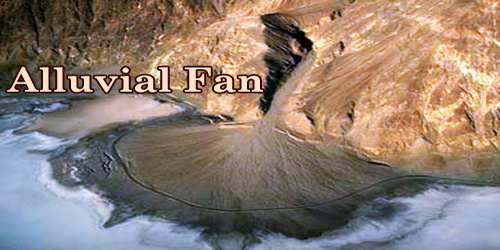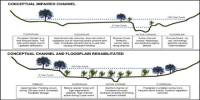Definition –
Alluvial Fan is a cone-shaped feature in the landscape where silt, gravel, sand, and sometimes boulders, have been deposited. That mix of stuff that has been deposited is called alluvium. Alluvial fans are usually created as flowing water interacts with mountains, hills, or the steep walls of canyons. Streams carrying alluvium can be trickles of rainwater, a fast-moving creek, a powerful river, or even runoff from agriculture or industry. As a stream flows down a hill, it picks up sand and other particles alluvium.
When the slope decreases rapidly into a relatively planar area or plateau, the stream loses the energy it needs to move its sediment. Deposition subsequently occurs and the sediment ultimately spreads out, creating an alluvial fan. Three primary zones occur within an alluvial fan which includes the proximal fan, medial fan, and the distal fan.
The deposits, which are generally fan-shaped in plan view, can develop under a wide range of climatic conditions and have been studied in the Canadian Arctic, Swedish Lappland, Japan, the Alps, the Himalayas, and other areas. They tend to be larger and more prominent in arid and semiarid regions, however, and generally are regarded as characteristic desert landforms. This is particularly true in the basin-and-range type of areas of parts of Iran, Afghanistan, Pakistan, the western United States, Chile and Peru, Sinai and western Arabia, and Central Asia, where the basic landscape configuration consists of mountains set against adjacent basins.
The rushing water carries alluvium to a flat plain, where the stream leaves its channel to spread out. Alluvium is deposited as the stream fans out, creating the familiar triangle-shaped feature. The narrow point of the alluvial fan is called its apex, while the wide triangle is the fan’s apron. Alluvial fans can be tiny, with an apron of just a few centimeters spreading out from the trickle of a drainpipe. They can also be enormous. Over time, water flowing down the Koshi River in Nepal, for example, has built up an alluvial fan more than 15,000 square kilometers (almost 5,800 square miles) wide. This “megafan” carries alluvium from the Himalaya Mountains.
Size of Alluvial Fan –
Alluvial Fans can exist on a wide spectrum of size scale. For example, alluvial fans can be on the order of only a few meters at the base and can be as large as 150 kilometers with a slope of 1.5-25 degrees. When numerous rivers/streams converge into a single plain, the fans can combine to form a continuous apron. In arid to semi-arid environments, this is referred to as a bajada and in humid climates the continuous fan apron is called a piedmont alluvial fan.
Types of Alluvial Fans –
A bajada is the convergence, or blending, of many alluvial fans. Bajadas are common in dry climates, such as the canyons of the American Southwest. Bajadas can be narrow, from the flow of two or three streams of water, or they can be wide, where dozens of alluvial fans converge.
Alluvial fans and bajadas are often found in deserts, where flash floods wash alluvium down from nearby hills. They can also be found in wetter climates, where streams are more common.
Alluvial fans are even found underwater. A subaqueous fan is created as an underwater current deposits alluvium from a submarine hill or glacier.
Sometimes, fans are formed without the aid of water. These are called colluvial fans. Colluvial fans are created by mass wasting. Mass wasting is simply the downward movement of rock, soil, or other material. Alluvium is material transported by water, while colluvium is material transported by mass wasting. Landslides are an instance of mass wasting that often creates colluvial fans.
A debris cone is a type of alluvial fan with a steep slope, closer to the shape of a half-cone than a flat fan. Debris cones can be created by the slow accumulation of alluvium over many centuries. They can also form as boulders and other large materials gather during landslides, floods, or other instances of mass wasting.

Alluvial Fan Formation –
The way alluvial fans form is not complicated, but it does need a particular set of circumstances. The recipe includes flowing water, sediment, a narrow passage between hills, mountains or canyon walls, and an open plain where the water and sediment exit the narrow passage.
As a stream’s gradient decreases, it drops coarse-grained material. It makes swagger of the channel and forces it to change direction and gradually build up a slightly mounded or shallow conical fan shape. The deposits are usually poorly sorted. This fan shape can also be explained with a thermodynamic justification: the system of sediment introduced at the apex of the fan will tend to a state which minimizes the sum of the transport energy involved in moving the sediment and the gravitational potential of material in the fan. There will be iso-transport energy lines forming concentric arcs about the discharge point at the apex of the fan. Thus the material will tend to be deposited equally about these lines, forming the characteristic fan shape.
Sources and Importance of Alluvial Fan –
Alluvial Fans are often found in desert areas often subjected to periodic flash floods from nearby thunderstorms in local hills. The typical watercourse in an arid climate has a large, funnel-shaped basin at the top, leading to a narrow defile, which opens out into an alluvial fan at the bottom. Multiple braided streams are usually present and active during water flows.
Phreatophytes are plants that are often concentrated at the base of alluvial fans. They have long tap roots 30 to 50 feet (9.1 to 15.2 m) to reach water that has seeped through the fan and hit an impermeable layer, sometimes collecting in springs and seeps. These stands of shrubs cling to the soil at their bases and often form islands of habitat for many animals as the wind blows the sand around the bushes away.
Alluvial fans are of practical and economic importance to society, particularly in arid and semiarid areas where they may be the principal groundwater source for irrigation farming and the sustenance of life. In some instances, entire cities, such as Los Angeles, have been built on alluvial fans.
Alluvial fans border the mountain fronts with the apex of each fan just within a canyon mouth that serves as the outlet for a mountain drainage system. Sediment from erosion within the mountains is moved by these drainage systems to the adjacent basin. In arid and semiarid regions, this is either an irregular or seasonal process driven by strongly seasonal rainfall or rapid snowmelt. Sediment transfer is thus frequently associated with sporadic flash floods that may include mudflows. The fans, the main sites of deposition, are therefore an intrinsic part of an erosional-depositional system in which mountains tend slowly to wear away and basins to fill with sediment through geologic time.
Alluvial fans also develop in wetter climates. In Nepal the Koshi River has built a megafan covering some 15,000 km2 (5,800 sq mi) below its exit from Himalayan foothills onto the nearly level plains where the river traverses into India before joining the Ganges. Along the upper Koshi tributaries, tectonic forces elevate the Himalayas several millimeters annually. Uplift is approximately in equilibrium with erosion, so the river annually carries some 100 million cubic meters (3.5 billion cu ft) of sediment as it exits the mountains. Deposition of this magnitude over millions of years is more than sufficient to account for the megafan.
Alluvial fans are built up in response to tectonic uplift, climatic change, and variations in the internal (autocyclic) balance between stream discharge, debris load, and surface gradient. Even in tectonically active mountains, climate can be a strong influence in alluvial fan development, as has been demonstrated in parts of the Himalayas.
An alluvial fan is considered active when there is still a sediment source continually feeding the fan sediment. One portion of the fan has flowing streams that are continually depositing sediment and the fan is still prograding into the alluvial plain. The feeder channels consist of straight channels as well as instances of braided channels because of the large volume of sediment sourced from the local uplands.
An alluvial fan can be large and may occupy a wide area, ranging from only a few metres in radius at its base to more than 150 km (95 miles). When a number of rivers discharge onto a plain, their fans may combine to create a piedmont alluvial fan.
Many fans in humid areas are actually fossil features created during earlier periods of intense erosion and deposition. The Plateau de Lannemezan on the northern side of the Pyrenees in France, for example, is a large piedmont alluvial fan that is still being built up by the tributaries of the Garonne and Adour rivers. This fan, though, is much too large to have been constructed by present-day rivers. It was formed during the late Cenozoic Era and is made up of coarse Pliocene gravels derived from the Pyrenees.
Information Sources:
















